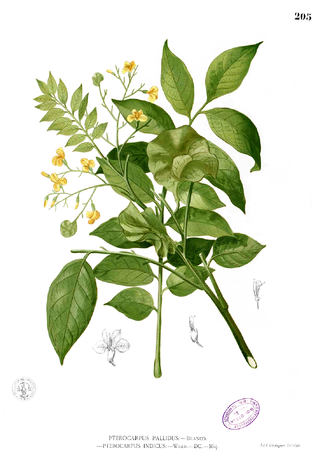
The zebu, sometimes known in the plural as indicine cattle, Camel cow or humped cattle, is a species or subspecies of domestic cattle originating in South Asia. Zebu, like many Sanga cattle breeds, differs from taurine cattle by a fatty hump on their shoulders, a large dewlap, and sometimes drooping ears. They are well adapted to withstanding high temperatures and are farmed throughout the tropics.

Pterocarpus is a pantropical genus of trees in the family Fabaceae. It belongs to the subfamily Faboideae, and was recently assigned to the informal monophyletic Pterocarpus clade within the Dalbergieae. Most species of Pterocarpus yield valuable timber traded as padauk, usually pronounced or ; other common names are mukwa or narra. The west African species may be traded as African rosewood. P. santalinus also yields the most precious red sandalwood in China known as Zitan. The wood from the narra tree and the Burmese padauk tree is marketed as amboyna when it has grown in the burl form. The scientific name is Latinized Ancient Greek and means "wing fruit", referring to the unusual shape of the seed pods in this genus.

The bronze-winged jacana is a wader in the family Jacanidae. It is found across South and Southeast Asia and is the sole species in the genus Metopidius. Like other jacanas it forages on lilies and other floating aquatic vegetation, the long feet spreading out its weight and preventing sinking. The sexes are alike but females are slightly larger and are polyandrous, maintaining a harem of males during the breeding season in the monsoon rains. Males maintain territories, with one male in the harem chosen to incubate the eggs and take care of the young. When threatened, young chicks may be carried to safety by the male under his wings.

The Indian prawn is one of the major commercial prawn species of the world. It is found in the Indo-West Pacific from eastern and south-eastern Africa, through India, Malaysia and Indonesia to southern China and northern Australia. Adult shrimp grow to a length of about 22 cm (9 in) and live on the seabed to depths of about 90 m (300 ft). The early developmental stages take place in the sea before the larvae move into estuaries. They return to the sea as sub-adults.

The Malayan tapir, also called Asian tapir, Asiatic tapir, oriental tapir, Indian tapir, piebald tapir, or black-and-white tapir, is the only living Tapir species outside of the Americas. It is native to Southeast Asia from the Malay Peninsula to Sumatra. It has been listed as Endangered on the IUCN Red List since 2008, as the population is estimated to comprise fewer than 2,500 mature individuals.

Pterocarpus indicus is a species of Pterocarpus native to southeastern Asia, northern Australasia, and the western Pacific Ocean islands, in Cambodia, southernmost China, East Timor, Indonesia, Malaysia, Papua New Guinea, the Philippines, the Ryukyu Islands, the Solomon Islands, Thailand, and Vietnam.

Nepenthesinfauna are the organisms that inhabit the pitchers of Nepenthes plants. These include fly and midge larvae, spiders, mites, ants, and even a species of crab, Geosesarma malayanum. The most common and conspicuous predators found in pitchers are mosquito larvae, which consume large numbers of other larvae during their development. Many of these animals are so specialised that they cannot survive anywhere else, and are referred to as nepenthebionts.

Hemidesmus indicus, Indian sarsaparilla, is a species of plant found in South Asia. It occurs over the greater part of India, from the upper Gangetic plain eastwards to Assam and in some places in central, western and South India.

Mucor is a microbial genus of approximately 40 species of molds in the family Mucoraceae. Species are commonly found in soil, digestive systems, plant surfaces, some cheeses like Tomme de Savoie, rotten vegetable matter and iron oxide residue in the biosorption process.

The red-faced mousebird is a species of mousebird or coly. It is a common in southern Africa from the Democratic Republic of Congo, Zambia and Tanzania south to the Cape. Its habitat is savanna with thickets, fynbos scrub, other open woodland, gardens and orchards.

Sporobolus is a nearly cosmopolitan genus of plants in the grass family. The name Sporobolus means "seed-thrower", and is derived from Ancient Greek word σπόρος (spóros), meaning "seed", and the root of βάλλειν (bállein) "to throw", referring to the dispersion of seeds. Members of the genus are usually called dropseeds or sacaton grasses. They are typical prairie and savanna plants, occurring in other types of open habitat in warmer climates. At least one species is threatened with extinction, and another is extinct.
The Bombay swamp eel, also known as the paytop in Marathi, is a species of fish in the family Synbranchidae. It is endemic to the state of Maharashtra in India.

Melilotus indicus, sometimes incorrectly written Melilotus indica, is a yellow-flowered herb native to northern Africa, Europe and Asia, but naturalized throughout the rest of the world.
Sarsaparilla often refers to the sarsaparilla soft drink, made from Smilax plants.

Sporobolus indicus is a species of grass known by the common name smut grass.












